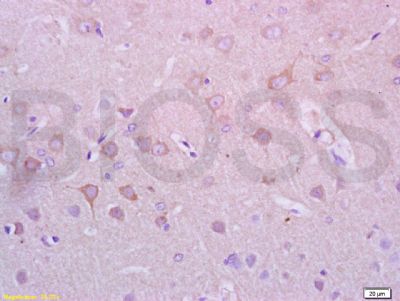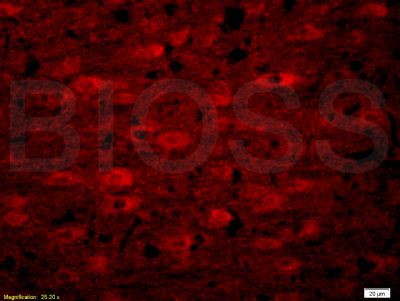
Alpha-Synuclein,核突触蛋白α抗体
产品名称: Alpha-Synuclein,核突触蛋白α抗体
英文名称: Anti-Alpha-Synuclein antibody
产品编号: HZ-0968R
产品价格: null
产品产地: 中国/美国
品牌商标: HZbscience
更新时间: 2023-08-17T10:24:20
使用范围: WB,ELISA,IHC-P,IHC-F,IF
- 联系人 : 鲍丽雯
- 地址 : 上海市闵行区闵北路88弄1-30号第22幢AQ136室
- 邮编 : 200612
- 所在区域 : 上海
- 电话 : 139****0749 点击查看
- 传真 : 点击查看
- 邮箱 : www.shzbio.net
- 二维码 : 点击查看
Alpha-Synuclein,核突触蛋白α抗体
产品编号HZ-0968R
英文名称Alpha-Synuclein
中文名称核突触蛋白α抗体
别 名Alpha synuclein; Alpha-Synuclein; Alpha-synuclein, isoform NACP140; alpha SYN; MGC105443; MGC110988; MGC127560; MGC64356; NACP; Non A beta component of AD amyloid; Non A4 component of amyloid precursor; Non-A-beta component of alzheimers disease amyloid , precursor of; Non-A beta component of AD amyloid; Non-A4 component of amyloid precursor; PARK 1; PARK 4; PARK1; PARK4; Parkinson disease (autosomal dominant, Lewy body) 4; Parkinson disease familial 1; PD 1; PD1; Syn; SNCA; Snca synuclein, alpha (non A4 component of amyloid precursor); SYUA_HUMAN; Synuclein alpha; Synuclein, alpha (non A4 component of amyloid precursor);
规格价格0.1ml/780元 购买 0.2ml/1280元 购买
说 明 书0.1ml 0.2ml
研究领域神经生物学
Alpha-Synuclein,核突触蛋白α抗体抗体来源Rabbit
克隆类型Polyclonal
交叉反应Human, Mouse, Rat,
产品应用WB=1:100-500 ELISA=1:500-1000 IHC-P=1:100-500 IHC-F=1:100-500 IF=1:100-500 (石蜡切片需做抗原修复)
not yet tested in other applications.
optimal dilutions/concentrations should be determined by the end user.
分 子 量14kDa
细胞定位细胞核 细胞浆 细胞膜
性 状Lyophilized or Liquid
浓 度1mg/1ml
免 疫 原Recombinant full length Alpha-Synuclein
亚 型IgG
纯化方法affinity purified by Protein A
储 存 液0.01M TBS(pH7.4) with 1% BSA, 0.03% Proclin300 and 50% Glycerol.
保存条件Store at -20 °C for one year. Avoid repeated freeze/thaw cycles. The lyophilized antibody is stable at room temperature for at least one month and for greater than a year when kept at -20°C. When reconstituted in sterile pH 7.4 0.01M PBS or diluent of antibody the antibody is stable for at least two weeks at 2-4 °C.
Alpha-Synuclein,核突触蛋白α抗体PubMedPubMed
产品介绍background:
The synucleins, including Alpha-synuclein (also designated NACP for nonamyloid component precursor),Beta-synuclein (also designated PNP 14 for phospho-neuroprotein 14)and Gamma-synuclein (also designated persyn or BCSG1 for breast cancer-specific gene 1)are presynaptic protein abundant in neurons. Alpha-synuclein, a component of Alzheimer’s disease amyloid plaques, is localized to neuronal cell bodies and synapses. Coordinate expression of Alpha-synucleinand Beta-synuclein may be important during hematopoetic cell differentiation. In patients with Parkinson’s disease, a mutant form of Alpha-synuclein has been found and Gamma-synuclein is associated with axonal pathology.
Function:
May be involved in the regulation of dopamine release and transport. Induces fibrillization of microtubule-associated protein tau. Reduces neuronal responsiveness to various apoptotic stimuli, leading to a decreased caspase-3 activation.
Subunit:
Soluble monomer which can form filamentous aggregates. Interacts with UCHL1 (By similarity). Interacts with phospholipase D and histones.
Subcellular Location:
Cytoplasm. Membrane. Nucleus. Cell junction, synapse. Note=Membrane-bound in dopaminergic neurons.
Tissue Specificity:
Expressed principally in brain but is also expressed in low concentrations in all tissues examined except in liver. Concentrated in presynaptic nerve terminals.
Post-translational modifications:
Phosphorylated, predominantly on serine residues. Phosphorylation by CK1 appears to occur on residues distinct from the residue phosphorylated by other kinases. Phosphorylation of Ser-129 is selective and extensive in synucleinopathy lesions. In vitro, phosphorylation at Ser-129 promoted insoluble fibril formation. Phosphorylated on Tyr-125 by a PTK2B-dependent pathway upon osmotic stress.
Hallmark lesions of neurodegenerative synucleinopathies contain alpha-synuclein that is modified by nitration of tyrosine residues and possibly by dityrosine cross-linking to generated stable oligomers.
Ubiquitinated. The predominant conjugate is the diubiquitinated form (By similarity).
Acetylation at Met-1 seems to be important for proper folding and native oligomeric structure.
Alpha-Synuclein,核突触蛋白α抗体DISEASE:
Note=Genetic alterations of SNCA resulting in aberrant polymerization into fibrils, are associated with several neurodegenerative diseases (synucleinopathies). SNCA fibrillar aggregates represent the major non A-beta component of Alzheimer disease amyloid plaque, and a major component of Lewy body inclusions. They are also found within Lewy body (LB)-like intraneuronal inclusions, glial inclusions and axonal spheroids in neurodegeneration with brain iron accumulation type 1.
Parkinson disease 1 (PARK1) [MIM:168601]: A complex neurodegenerative disorder characterized by bradykinesia, resting tremor, muscular rigidity and postural instability. Additional features are characteristic postural abnormalities, dysautonomia, dystonic cramps, and dementia. The pathology of Parkinson disease involves the loss of dopaminergic neurons in the substantia nigra and the presence of Lewy bodies (intraneuronal accumulations of aggregated proteins), in surviving neurons in various areas of the brain. The disease is progressive and usually manifests after the age of 50 years, although early-onset cases (before 50 years) are known. The majority of the cases are sporadic suggesting a multifactorial etiology based on environmental and genetic factors. However, some patients present with a positive family history for the disease. Familial forms of the disease usually begin at earlier ages and are associated with atypical clinical features. Note=The disease is caused by mutations affecting the gene represented in this entry. [DISEASE] Parkinson disease 4 (PARK4) [MIM:605543]: A complex neurodegenerative disorder with manifestations ranging from typical Parkinson disease to dementia with Lewy bodies. Clinical features include parkinsonian symptoms (resting tremor, rigidity, postural instability and bradykinesia), dementia, diffuse Lewy body pathology, autonomic dysfunction, hallucinations and paranoia. Note=The disease is caused by mutations affecting the gene represented in this entry.
Dementia Lewy body (DLB) [MIM:127750]: A neurodegenerative disorder characterized by mental impairment leading to dementia, parkinsonism, fluctuating cognitive function, visual hallucinations, falls, syncopal episodes, and sensitivity to neuroleptic medication. Brainstem or cortical intraneuronal accumulations of aggregated proteins (Lewy bodies) are the only essential pathologic features. Patients may also have hippocampal and neocortical senile plaques, sometimes in sufficient number to fulfill the diagnostic criteria for Alzheimer disease. Note=The disease is caused by mutations affecting the gene represented in this entry.
Similarity:
Belongs to the synuclein family.
Gene ID:
6622
Database links:
Entrez Gene: 6622 Human
Entrez Gene: 20617 Mouse
Entrez Gene: 29219 Rat
Omim: 163890 Human
SwissProt: P37840 Human
SwissProt: O55042 Mouse
SwissProt: P37377 Rat
Unigene: 21374 Human
Unigene: 17484 Mouse
Unigene: 1827 Rat
Important Note:
This product as supplied is intended for research use only, not for use in human, therapeutic or diagnostic applications.
神经生物学相关蛋白(Neurobiology)
Synuclein 包括α-Synuclein,β-Synuclein 和γ-Synuclein 是神经细胞中富含的前突触蛋白。α-Synuclein,Alzheimer’(AD)病淀粉样蛋白沉积的成份之一,集中分布在神经细胞的包体和突触。在帕金森病人中发现有α-Synuclein的变异型,而γ-Synuclein与轴突病理学有关。
此抗体将为Lewy小体痴呆症、Parkinson症、AD和其它一些神经性疾病提供有用的病理诊断。


